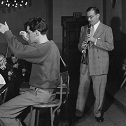Classical Compositions Commissioned by Benny Goodman: Artistic Strategies, References, and Controversies

Classical Compositions Commissioned by Benny Goodman: Artistic Strategies, References, and Controversies
FWF-Project J4281-G26 (Erwin Schrödinger International Fellowship, with return phase)
Head: Mag. Dr. Elisabeth Reisinger
Guest institution abroad: Harvard University (2019/09–2020/06); Return phase at the University of Vienna (2020/08–2021/08)
Informationen auf Deutsch
Clarinetist Benny Goodman (1909–1986) is considered one of the leading 20th-century jazz soloists. Hardly known is that from the 1930s, after establishing himself as bandleader and “King of Swing,” he also engaged with classical repertoire, performing it on the stage as well as recording it. In 1938, Goodman granted his first commission to a classical composer: Bela Bartók wrote the piece Contrasts for Clarinet, Violin, and Piano for Goodman and the violin virtuoso Joseph Szigeti. Several similar projects followed, containing commissions to Darius Milhaud, Paul Hindemith, and Aaron Copland. What motivated Goodman to place those orders? What considerations figured into his choice of composers? How did they address the requirements and skills of their commissioner? How were those pieces, their performances and recordings by Goodman, as well as the performer himself as “classical musician,” perceived by the contemporary public?
Most likely, Goodman’s activities as commissioner have to be understood in the context of his efforts to also establish himself as performer of classical repertoire. However, a “historical consciousness”– to go down in music history – should also be considered. The prominent names among the composers who delivered compositions to Goodman are eye-catching. He clearly addressed persons who had already achieved certain fame. Further, it should be asked how those composers dealt with their not lesser known commissioner, an established jazz soloist, and how the designated performer, who legally secured for himself exclusive performing rights for the commissioned music for several years, might have influenced the compositional process.
Based on a variety of material (correspondences, composing sketches, concert reviews, sound recordings), on one hand this project shall lead to new knowledge about a still almost unknown aspect in the career of an exceptional artist and the genesis of a most interesting spectrum of the 20th-century repertoire for solo clarinet. On the other, for the first time this study also sheds light on performers as commissioners and sponsors for new music, dealing with questions on their premises, motivations, and strategies, their self-concepts, as well as the exchange and relations between composers and performers.
Image: Benny Goodman and Leonard Bernstein, rehearsing with the New York City Symphony Orchestra 1946 (William P. Gottlieb, public domain, retrieved from the Library of Congress: www.loc.gov/item/gottlieb.00731/)
